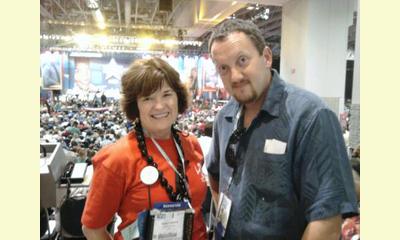|
|
Hawaii Teachers Impact NEA National Assembly – 3 Million Members to Support Peace Day
un articulo por Damon Tucker
The National Education Association today approved a New Business Item (NBI) at its annual Representative Assembly in Washington, D.C., urging its more than three million members to support the International Day of Peace. Justin Hughey of the Hawai‘i delegation presented the NBI to the 8,000 delegates at the forum.

Nancy Porter (Iowa) of the Peace and Justice Caucus, and Justin Hughey (Hawaii), who submitted the resolution
click on photo to enlarge
“If humans can figure out how to stop killing each other, we won’t have a problem funding a quality public education for every child,” said Hughey.
The International Day of Peace, September 21, has been officially recognized by the UN since 1981, and traditionally marks the opening of that body’s annual session. The NEA, the largest teachers union in the world, stands for many of the same values that are part of the UN’s mission of peace. These include equality, economic justice, good health, and preservation of the environment.
“This is an example of how teachers in Hawai‘i and around the nation are making a difference,” added Wil Okabe, president of the Hawai‘i State Teachers Association. “From their classrooms, teachers can help build a nation with more respect and compassion for the welfare and rights of all people, as well as for the safekeeping of our precious environment.”
The legislature of the State of Hawai‘i, lobbied by the Junior Young Buddhists Association of teenagers in 2007, became the first and only state in America to have a permanent Peace Day. The Peace Committee of Hawai‘i and hundreds of other organizations celebrate the International Day of Peace throughout the world, yet it remains largely unknown to the general public.
Jeanne Clement (Honoka‘a High and Intermediate School) secured the necessary signatures needed for submission by Hughey (King Kamehameha III School). The NBI was drafted by Miles Okumura of the Peace Committee, assisted by Nancy Porter (Iowa) of the Peace and Justice Caucus. (www.neapeaceandjustice.org) Okumura (Honoka‘a High and Intermediate) is a member of the Caucus and recipient of the United Nations Association of Hawai‘i “Peacemaker of the Year” award.
“As educators, we have the potential to make this world a better place by teaching the next generation the values of peace, compassion and awareness of interdependence of life,” said Okumura. “100,000 teachers can reach 15 million future citizens every year with just one lesson plan a year. Over the course of our careers, we can raise and educate hundreds of millions of citizens.”
The Peace Committee produces the “Annual Parade and Festival for the United Nations International Day of Peace” in Honoka‘a on the Big Island of Hawai‘i. It is the largest and most elaborate celebration of its kind in the world, now in its sixth year. Programs include peace education and activities such as the Peace Poster contest. (www.peacedayparade.org ).
|








|
DISCUSSION
Pregunta(s) relacionada(s) al artículo :
Peace Studies in School Curricula, What would it take to make it happen around the world?
* * * * *
Comentario más reciente:
:
During the Asian Educators Symposium, we found out that Peace Education is still not part of the school curriculum in most countries. However, the participating teachers have been incorporating peace education in their teaching subjects, such as English, social studies, and character education. We all agreed that love and the will to nurture peace in children are the most important basis for peace education. Even if peace education is not a part of the curriculum, peace can be taught through any subject. Whatever you are teaching, if it comes from the heart, then it will touch the minds of children.

|
|









